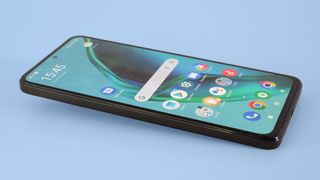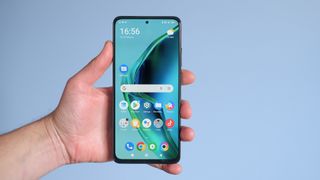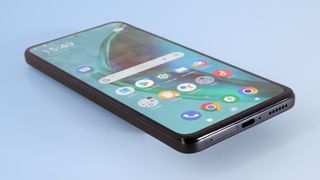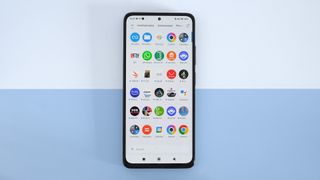TechRadar Verdict
The Xiaomi Poco X4 Pro doesn’t feel like a Poco phone but is a sound buy if you’re looking for a strong screen, battery life and speakers, and can live with its limited gaming power and inconsistent camera.
Pros
- +
Vibrant OLED screen
- +
Affordable 5G
- +
Less bulky than its predecessors
- +
Long battery life
Cons
- -
Inconsistent camera; poor Auto HDR
- -
Weak gaming performance for a Poco phone
- -
Annoying charging and app-closing bugs
Why you can trust TechRadar
Two-minute review
The Xiaomi Poco X4 Pro 5G isn’t a typical Poco phone. Headline-grabbing Poco handsets of the past have had truly exceptional characteristics in one area. That was performance in the Pocophone F1, Poco F3 and Poco X3 Pro; and at the time, the Poco X3 NFC was almost unbeatable for its sheer value.
Xiaomi’s direction with the Poco X4 Pro is less clear, not helped by it effectively being a near-replica of the Xiaomi Redmi Note 11 Pro, with a few tweaks.
You don’t get the standard-setting performance of the classic Poco models. And while the 108MP camera is solid enough by the standards of the series, it doesn’t challenge a Google Pixel 5a or OnePlus Nord CE 2 5G.
With the Poco X4 Pro, Xiaomi is aiming for a balance that has rarely been the focus of the Poco series.
Does it work? Somewhat. The design is less of an eyesore over some Poco phones. Its OLED screen is largely excellent, the stereo speakers well above average, and battery life is great. A glass, rather than plastic, rear is a nice touch, too.
However, there are some issues. The Xiaomi Poco X4 Pro has an annoying habit of closing down any apps running in the background, which isn’t helpful if you stream audio through your phone.
Its charging behavior is strange, too, with a bug causing the screen to continually light up. Plus, the Snapdragon 695 processor doesn’t really belong in a Poco phone, as they’re typically more powerful than that.

The often very cheap Poco X3 Pro is almost three times as powerful as the Poco X4 Pro 5G by some gaming metrics. While the 108MP camera appears to make up for it on paper, this doesn’t pan out in practice due to a weak Auto HDR mode that too-frequently results in overexposure and dull-looking pictures.
This phone may get better all-round with successive software updates. But if the aforementioned issues are tied to the compromises inherent in its Snapdragon 695 processor, it may well not. There’s plenty to like here, but we can’t help but feel that Poco series fans will end up disappointed by the Poco X4 Pro 5G.
Xiaomi Poco X4 Pro 5G price and availability
- Announced in February 2022
- Starts at AED990 in the UAE for 6GB/128GB variant.
At the time of this review, our 8GB/256GB model was priced at AED1095 here in the UAE. At just a little lesser, you also do still have the option of the Poco X3 Pro as well as this year's budget offering from the brand. the Poco M4 Pro.

Design
- Slimmer, boxier design
- Flat glass-back panel
- Good stereo speakers
The design language of the Poco X series has changed, fairly dramatically. The thick and chunky bodies of the Poco X3 Pro and Poco X3 NFC are out, replaced by a slimmer but more severe frame.
The Poco X4 Pro is much less of a palm-filler as a result, easier to handle than the Poco X3 Pro. In addition, where the X3’s outer shell is all-plastic, the X4 Pro has a flat, glass rear panel. The phone’s sides remain plastic, but the overall feel of the device is a net improvement.
That 'flex' is the extended glass platform that sits over much of the phone’s width. There doesn’t appear to be much point to it, other than such moves can appear to make the camera array seem more advanced than it is.
The Poco X4 Pro 5G’s glass back does have a light-reactive layer beneath the glass, which generates light shafts, a bit like search lights pointed into a night sky. It isn’t garish; in fact, the effect will often be muted by the sheer number of fingerprint smudges the rear glass picks up. Phones like the Oppo Reno 7 Pro 5G with its Starlight colour tend to avoid these issues with their matte backs.

You can opt for a bolder version of the phone, in blue and bright yellow. We haven’t seen the latter in person, but it looks great in renders.
To subdue the light reactive rear, you could use the bundled case. This also highlights that big chunk of camera glass, ensuring the Poco X4 Pro looks distinctive both in and out of its case.
Elsewhere, the Poco X4 Pro is strong on audio. You get a 3.5mm headphone jack and a very solid pair of stereo speakers. They’re loud and, for a phone, offer good lower-frequency output. We’ve listened to countless hours of podcasts and streamed radio on this Poco handset, and it does a great job.
The Poco X4 Pro also comes with an IR blaster, enabling the Poco to function as a universal remote. Water/dust-resistance is a basic but useful IP53, which is fine to tolerate some rain but little more, and the fingerprint scanner is nippy and sits on the side, within the power button.
Finally, the SIM tray has two slots. The second can be used for either a second SIM or a microSD card. Our review phone has 256GB of storage, but there’s also a 128GB version of the Poco X4 Pro.
Display
- Strong image quality
- Good in bright conditions
- Oversaturated as standard, but color is customisable
The Poco X4 Pro has a largely excellent 6.67-inch AMOLED screen. Xiaomi has already established very high standards among budget phones, using Full HD displays even in its fairly cheap models; but the screen here is better than the display of the Poco X3 phones.
OLED provides deeper contrast, with peak brightness higher too. Most noticeable has been that the Poco X4 Pro 5G switches into a completely new gear when the ambient light level gets very high.
You can test this for yourself, if you’re by a window with bright sunlight beaming through. Put the Poco X4 Pro under the beam and you’ll see the OLED panel’s colour and contrast shift to maximise visibility. It works well, and is the kind of feature we’d only have associated with true top-end phones just a couple of years ago.
Colour depth is great, too, although you may wish to drop down from Vivid to Standard mode, if you don’t want your app icons to look oversaturated. In most cases, the 'vivid' tones of the display seemed to be quite aggressive and things got better once the setting was toggled.

The 2400 x 1080 pixel resolution doesn’t quite deliver the sharpness and smoothness of an ultra-high resolution screen, but it’s the best you can ask for in a phone at this price. Note, too, that this is a 120Hz screen. Our Poco X4 Pro 5G came set to a 60Hz refresh rate, but 120Hz makes scrolling menus appear smoother, but at a cost to battery life.
We found the Poco X4 Pro battery life to be good in either mode, so we recommend using 120Hz.
Dynamic refresh rate is one of the few missing features here. Some high-end phones can switch refresh rate on-the-fly to maximize battery life. The Poco X4 Pro sticks at 120Hz unless you run an app or game that doesn’t support 120Hz, in which case it reverts to 60Hz.
HDR is lacking, too – according to our testing at least. YouTube HDR videos play in standard dynamic range only. We find the excellent contrast of OLED to be a greater asset here, although older Xiaomi phones such as the Redmi Note 10 Pro do support HDR.
Software and performance
- A relatively weak processor for a Poco-series phone
- Aggressive power management has annoying effects
- Solid enough day-to-day performance
The Poco X4 Pro runs Android 11 and Xiaomi’s MIUI 13. It’s a recent version of Android, the latest of the Xiaomi interface. And the top-most visual layer is Poco Launcher, which determines the look and feel of the skin.
It’s similar to the Poco X3 Pro. You get an app drawer with a plain white background, and there’s a dark mode for those who may prefer a moody look.
As in other recent Xiaomi phones, the drop-down menus have a non-standard style. Flicks down from the right side of the screen summon the feature toggles; left-flicks pull down your notifications. It takes a while to get used to, but you can also jump between them with left-right swipes on the Poco X4 Pro screen.
This is perhaps the most contentious part, so long as your head doesn’t explode on seeing a few unwanted preinstalled apps. The Poco X4 Pro comes with a few games, such as Tile Fun and State of Survival X Walking Dead, plus the Poco Community and Poco Store apps – but you can delete them.

General performance is good, with a few expected, and unexpected, niggles. The Poco X4 Pro’s app loads aren’t instantaneous, but are comparable with the more powerful Poco X3 Pro. Its multitasking screen is jerky, even in 120Hz mode – not an issue in the Poco X3 Pro, but it seems more a software quirk than anything else. The multitasking menu displays thumbnails of apps in their previous state, not a window of them actually running.
This phone will occasionally shut down apps streaming/playing audio in the background. It’s something you see in a phone whose power management is a bit too aggressive. Saving battery life is good, but not when it impacts day-to-day use. A fix could come via a software update but there's no confirmation of the same.
Such an update won’t dramatically improve the Poco X4 Pro, the device is ordinary at best, as a result of its Qualcomm's Snapdragon 695 processor.
This is part of an important but sometimes frustrating breed of SoC: the affordable 5G chipset. Some are brilliant – such as the original king of budget 5G, the Snapdragon 765G. However, chipsets such as the Snapdragon 695 suggest that, just maybe, a MediaTek Dimensity chipset may be a better fit these days.

Gaming Performance
Just look at the Poco X4 Pro’s 3DMark Wild Life test scores. It achieves 1207 points, which doesn’t come close to the last-generation Poco X3 Pro’s 3450 points.
This also plays out in actual games. In Call of Duty: Mobile, we got a constant 48-52fps at the maximum graphics settings. It was able to reach 60fps on a few occasions but only when there is no proper action happening on-screen. PUBG Mobile and Asphalt 9 both performed similarly with a mostly stable 30fps across the board (the maximum fps the games allows), with occasional dips to 28fps during action heavy sequences or when the game would attempt to load textures. PUBG Mobile does support HDR and Ultra HD modes but they weren’t available for the device at the time of writing this review.
Fortnite on the other hand remained a largely choppy experience. Even with the game capped at 30fps, and seemingly using the low texture mode (we couldn’t get it to enable high texture mode for some reason), the fps bounced between 20fps to 30fps with a lot of stutter and laggy gameplay. Texture pop-in was also a major issue and would cause micro-stutters of around 1-2 seconds.
In terms of heat management, the device gets warm all around its body but even after 30-40mins of play, it never got too hot too touch. We would still recommend a case for a better grip as the smooth glass back design in sweaty hands but might be a recipe for disaster.
Cameras
- Typically weak secondary cameras
- Solid main camera hardware let down by mediocre processing
- Weak video, limited to 1080p/30
Has Xiaomi traded the Poco series’s signature powerful processor for a top-class camera? Not really, but parts of it do sound good on paper.
The Poco X4 Pro 5G has a 108-megapixel primary camera, an 8-megapixel ultra-wide, and a 2-megapixel zoom ( a combination we'll never understand). The last two are the typical fodder of upper entry-level phones. The wide is okay, but somewhat soft as a result of its limited sensor resolution — and the sensor is small, leading to limited dynamic range in trickier scenes.
The macro is a filler camera, its 2-megapixel resolution incapable of capturing any image worth saving, even if it does let you get quite close to your subject. Xiaomi makes one of the best affordable macro cameras, the 5-megapixel telephoto in the Redmi Note 10 Pro. This one is nothing like it.
The Poco X4 Pro camera rests on the 108-megapixel primary, which uses a Samsung HM2 sensor. It’s the same camera that sits in the similarly priced Redmi Note 10 Pro 5G, and the far more expensive Xiaomi 11T Pro. Which must be good news, right?
This camera’s image quality is variable. Image processing, including noise reduction, is significantly worse than some of Xiaomi’s previous efforts at this price — including, not surprisingly, the Xiaomi 11T Pro. This is evident up-close, where fine detail looks fuzzier than that on images taken with last year’s Redmi Note 10 Pro.
The somewhat weak Auto HDR mode’s effects are more notable. In some phones, Xiaomi’s Auto HDR is up there with the best, kicking in when there’s a lot of light contrast in a scene, when a single-exposure shot is either going to leave you with a blown-out sky or murky-looking foreground, or both.

Night shooting isn’t terrible either, relying on a dedicated Night mode that genuinely improves dynamic range and reduces noise dramatically, taking images from “poor” to “OK”. It won’t get close to those captured with a Google Pixel 5a, mind.
Learn how to get the most from the Poco X4 Pro camera and you can achieve better results than the Poco X3 Pro. But general camera performance is a step down across the board from last year’s Xiaomi Redmi Note 10 Pro – which is disappointing.
There’s some more bad news, too – and another opportunity to bash the Snapdragon 695. It restricts the Poco X4 Pro to 1080p video capture at 30 frames per second. There’s no 4K capture, no standard 60fps shooting, even if you drop the resolution to 720p. This seems a bit odd when there’s a slo-mo mode with 120fps at 720p.
The Poco X4 Pro crops into the view when you shoot video, suggesting the use of software stabilization. But the wobbly test footage we took at 1080p/30fps shows it’s at best very limited.
Finishing up, the selfie camera has a 16-megapixel sensor that, by default, smoothes out skin excessively. You can switch this processing off for more natural-looking images, and results are solid in good lighting; but detail does fall away in indoor settings.
Camera samples











Battery life
- Long battery life, particularly at the 60Hz refresh rate
- Fast 67W charging
- Suffers from a weird charging bug
Coming back to the good stuff, the Poco X4 Pro is a long-lasting phone. For the first few days of testing we kept the handset at the default 60Hz screen mode, and could be left with as much as 45% battery life by bedtime. We’re not particularly light users, so this is a great result.
Switching to 120Hz didn’t change things by much, either. Battery life is strong in either setting, and while this doesn’t make much sense, the Poco X4 Pro anecdotally seems to outlast the Redmi Note 11 Pro 5G. They have the same CPU, the same 5000mAh battery capacity and what appears to be the same display panel.
Part of the testing took place through covid isolation, however — your phone’s screen will always use less battery if it doesn’t need to ramp up to compete with the light of the great outdoors. Still, the Poco X4 Pro is a trooper.

The handset also comes with Xiaomi’s mid-level 67W fast-charging standard. Xiaomi offers speeds up to 120W today, but 67W is still a lot more powerful than anything Samsung or Apple provides.
While it's great to have these charging speeds, it isn’t quite as nippy as wewould've expected. On plugging in just seconds before the Poco X4 Pro switches off from low charge, it reaches 30% in 10 minutes, hits 50% charge at the 20-minute mark, and reaches 70% after 30 minutes. Great stuff.
However, it slows down significantly thereafter. This is normal, but following 60 minutes, the Poco X4 Pro wasn’t quite full, sitting at 98%. And like most other phones at the price, the Poco X4 Pro doesn’t support wireless charging.
Should you buy the Xiaomi Poco X4 Pro 5G?

Buy it if...
A great screen is a priority
The Poco X4 Pro has a large, colorful, bright and bold OLED screen, plus a max 120Hz refresh rate matches the best available in a cheaper phone, too. You won’t get much better than this.
You value decent sound
Good stereo speakers make the Poco X4 Pro a solid phone for music and podcast fans. These speakers cut through ambient noise and are well positioned for gaming and movies.
You want good battery life
The Poco X4 Pro offers excellent battery life with the 60Hz display mode, and remains decent at 120Hz. While we couldn’t get it to last a full two days, some of you will. Charging is nippy too.
Don't buy it if...
You’re a fan of mobile gaming
The Poco X4 Pro’s processor affords it only entry-level gaming performance that can’t match earlier Poco phones. Xiaomi’s Poco X3 Pro is far more powerful and will cost you just a bit lesser.
You’re a happy snapper
While the Poco X4 Pro has a camera sensor that has yielded good results in other phones, here it’s slightly disappointing. It is capable of good results, but Auto HDR mode feels underpowered. And while some of the issues raised can be fixed using the manual “full” HDR mode, its results can lack subtlety and it asks a little too much of the casual photographer.
Shooting video is a priority
The Poco X4 Pro’s Snapdragon 695 processor limits the phone to 1080p, 30 frames per second, video capture. This is poor even among affordable phones. And while there’s some suggestion the camera uses software stabilization, there’s little evidence of it in the final footage.
First reviewed: March 2022
Andrew is a freelance journalist and has been writing and editing for some of the UK's top tech and lifestyle publications including TrustedReviews, Stuff, T3, TechRadar, Lifehacker and others.

